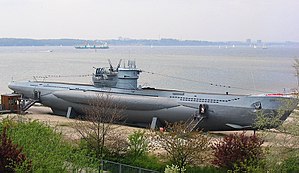
German submarine U-1277
 U-995 Type VIIC/41 at the Laboe Naval Memorial. This U-boat is almost identical to U-1277.
| |
| History | |
|---|---|
| Name | U-1277 |
| Ordered | 13 June 1942 |
| Builder | Bremer Vulkan AG, Bremen |
| Yard number | 72 |
| Laid down | 6 August 1943 |
| Launched | 18 March 1944 |
| Commissioned | 3 May 1944 |
| Fate | Scuttled on 3 June 1945 in the North Atlantic off the coast of Portugal near Oporto |
| General characteristics [1] | |
| Type | Type VIIC/41 submarine |
| Displacement | |
| Length |
|
| Beam |
|
| Height | 9.60 m (31 ft 6 in) |
| Draught | 4.74 m (15 ft 7 in) |
| Installed power |
|
| Propulsion |
|
| Speed |
|
| Range | |
| Test depth |
|
| Complement | 44-52 officers & ratings |
| Armament |
|
| Service record | |
| Part of: |
|
| Identification codes: | M 07 218 |
| Commanders: | |
| Operations: |
|
| Victories: | None |
German submarine U-1277 was a Type VIIC/41 U-boat of Nazi Germany's Kriegsmarine during World War II.

She was ordered on 13 June 1942, and was laid down on 6 August 1943 at Bremer Vulkan AG, Bremen, as yard number 72. She was launched on 18 March 1944 and commissioned under the command of Oberleutnant zur See Ehrenreich-Peter Stever on 3 May 1944.[1]

Design
German Type VIIC/41 submarines were preceded by the heavier Type VIIC submarines. U-1277 had a displacement of 759 tonnes (747 long tons) when at the surface and 860 tonnes (850 long tons) while submerged.[3] She had a total length of 67.10 m (220 ft 2 in), a pressure hull length of 50.50 m (165 ft 8 in), a beam of 6.20 m (20 ft 4 in), a height of 9.60 m (31 ft 6 in), and a draught of 4.74 m (15 ft 7 in). The submarine was powered by two Germaniawerft F46 four-stroke, six-cylinder supercharged diesel engines producing a total of 2,800 to 3,200 metric horsepower (2,060 to 2,350 kW; 2,760 to 3,160 shp) for use while surfaced, two AEG GU 460/8–27 double-acting electric motors producing a total of 750 metric horsepower (550 kW; 740 shp) for use while submerged. She had two shafts and two 1.23 m (4 ft) propellers. The boat was capable of operating at depths of up to 230 metres (750 ft).[3]

The submarine had a maximum surface speed of 17.7 knots (32.8 km/h; 20.4 mph) and a maximum submerged speed of 7.6 knots (14.1 km/h; 8.7 mph).[3] When submerged, the boat could operate for 80 nautical miles (150 km; 92 mi) at 4 knots (7.4 km/h; 4.6 mph); when surfaced, she could travel 8,500 nautical miles (15,700 km; 9,800 mi) at 10 knots (19 km/h; 12 mph). U-1277 was fitted with five 53.3 cm (21 in) torpedo tubes (four fitted at the bow and one at the stern), fourteen torpedoes, one 8.8 cm (3.46 in) SK C/35 naval gun, (220 rounds), one 3.7 cm (1.5 in) Flak M42 and two 2 cm (0.79 in) C/30 anti-aircraft guns. The boat had a complement of between forty-four and sixty.[3]

Service history
U-1277 is unusual in so much that it either did not receive Dönitz's surrender order on 8 May 1945, or chose to ignore it. What is known is that she continued her patrol in the North Atlantic for a further month, her crew finally scuttling her on 3 June 1945 off the northern coast of Portugal. All 47 crew disembarked safely from their sinking boat in rubber dinghies and made their way ashore, landing on the beach at Angeiras, Portugal. There they were interned by the Portuguese authorities, and handed over to a British warship a few days later. The crew were not released from a POW camp until 1947.

The wreck now lies in 100 feet (30 m) of water at 41°13′N 08°45′W / 41.217°N 8.750°W.

See also
References
- ^ a b Helgason, Guðmundur. "Type VIIC/41". German U-boats of WWII - uboat.net. Retrieved 11 May 2015.
- ^ Helgason, Guðmundur. "Ehrenreich-Peter Stever". German U-boats of WWII - uboat.net. Retrieved 11 May 2015.
- ^ a b c d Gröner 1991, pp. 43–46.
Bibliography
- Busch, Rainer; Röll, Hans-Joachim (1999). German U-boat commanders of World War II : a biographical dictionary. Translated by Brooks, Geoffrey. London, Annapolis, Md: Greenhill Books, Naval Institute Press. ISBN 1-55750-186-6.
- Busch, Rainer; Röll, Hans-Joachim (1999). Deutsche U-Boot-Verluste von September 1939 bis Mai 1945 [German U-boat losses from September 1939 to May 1945]. Der U-Boot-Krieg (in German). Vol. IV. Hamburg, Berlin, Bonn: Mittler. ISBN 3-8132-0514-2.
- Gröner, Erich; Jung, Dieter; Maass, Martin (1991). U-boats and Mine Warfare Vessels. German Warships 1815–1945. Vol. 2. Translated by Thomas, Keith; Magowan, Rachel. London: Conway Maritime Press. ISBN 0-85177-593-4.

See what we do next...
OR
By submitting your email or phone number, you're giving mschf permission to send you email and/or recurring marketing texts. Data rates may apply. Text stop to cancel, help for help.
Success: You're subscribed now !
